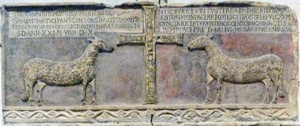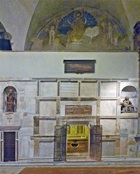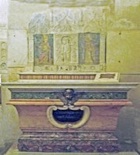


The Roman Martyrology records, under 29th June:
-
“At Narni, St Cassius, bishop of that city. St. Gregory relates that he permitted scarcely any day of his life to pass without offering propitiation to Almighty God. It was in character with his life, for he distributed in alms all he possessed, and his devotion was such that abundant tears flowed from his eyes during the holy Sacrifice. At last, coming to Rome on the birthday of the apostles, as was his yearly custom, after having solemnly celebrated Mass and given the Lord's Body and the kiss of peace to all, he departed for Heaven”.
The funerary inscription (CIL XI 4164) of St Cassius survives, embedded in the screen of the Sacello di San Cassio in the Duomo (see below). It is part of a relief (illustrated above) that depicts two lambs and a cross. The inscription also commemorates Fausta, the wife of St Cassius, who had pre-deceased him. The text, which is written in the first person, reads:
CASSIVS INMERITO PRESUL DE MVNERE CRISTI
HIC SVA RESTIVO TERRAE MIHI CREDITA MEMB[RA]
QVEM FATO ANTICIPANS CONSORS DVLICISSIMA VITAE
ANTE MEVM IN PACEM REQVIESCIT FAVSTA SEPVLCRVM
TV ROGO QVISQVIS ADES PRECE NOS MEMORARE BENIGNA
CVNCTA RECEPTVRVM TE NOSCENS CONGRVA FACTIS
S .D. ANN.XXI. M.VIIII. D.X
R.Q. IN PACE PRID. KAL. IVL P.C. BASILI VC ANN. XVII
It contains two important dates:
-
✴St Cassius died on “PRID KAL IVL” (30th June), 17 years after the year of the Consul Basil (who was in office in Byzantium in 541) - i.e. on 30th June 558. This formula was used because Narni was in Byzantine hands at the time.
-
✴He had held the post of bishop for 21 years, 8 months and 10 days - i.e. he had been consecrated on 19th October, 536.
St Cassius is mentioned twice in the “Dialogues” of St Gregory:
-
✴Totila despised him because his florid complexion made him look like an alcoholic. However, when he expelled a demon that was tormenting one of Totila's guards, Totila revered him. (Totila held Narni for an unknown time during the period 536-52: the account by St Gregory suggests that St Cassius enjoyed a degree of moral authority during this occupation).
-
✴St Cassius usually said Mass every day (as noted in the Roman Martyrology above). One of his priests prophesied that he would receive his reward for this when he died, which would happen on the feast of SS Peter and Paul. He did indeed die after saying Mass on this day, seven years after the prophecy.
St Gregory recorded the events leading to the death of St Cassius at greater length in his “Homiliarum in Evangelia” (2:37): interestingly, he records that St Cassius celebrated the daily Mass on the tomb of St Juvenal. There must therefore have been a chapel over this tomb, which is known to have been close to the what is now known as the Sacello di San Cassio (see below). There is circumstantial evidence to suggest that it served as a funerary chapel for the bishops of Narni. This was almost certainly the site of the grave of St Cassius and Fausta.
Relics of St Cassius
Adalbert I, Margrave of Tuscany destroyed the funerary chapel when he sacked Narni in 878, after he had participated in an attack on Rome in an effort to force Pope John VIII to crown Carloman as Holy Roman Emperor. He stole the relics of SS Juvenal and Cassius and those of Fausta, and took them to San Frediano, Lucca. These events are recorded in the account of the life of St Cassius in the “Passionario Lucchese” (12th century): “Sarcofaga rupta sunt, mausolea fracta, corpora sanctorum abstracta sunt, vehicula parata”.


Miracle of St Cassius (1680)
This panel in the Museo Diocesano, Terni, which is attributed to Girolamo Troppa, depicts a miracle that happened when the relics of St Cassius were returned to Narni in 1679.




